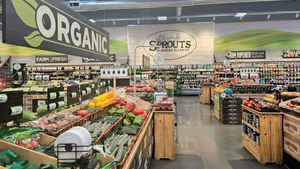Produce cost anxieties weigh on supermarket consumersProduce cost anxieties weigh on supermarket consumers
Price remains a top purchase driver despite inflationary declines
September 18, 2024

Price concerns are having a growing influence on shopper interest in produce.
In a nationally representative August survey of 1,628 consumers for the Southeast Produce Council’s What’s New? 2024 report, 33% of shoppers listed money/budget as their top purchase driver, up from 32% in 2023, and the leading overall driver.
Despite an easing of inflation and deflation, 76% of consumers still believe that produce prices are higher than the previous year, the survey found.
“The combined impact of several years of inflation in all things life has changed what, how much, and where people purchase produce,” said David Sherrod, president and chief executive officer of the Millen, Ga.-based Southeast Produce Council. “More people are buying produce at value-focused formats, such as supercenters and club stores. Shoppers also are more flexible in what they buy, with dollars moving to items that are on sale, and they are moving to items that are versatile and have long shelf-life.”
Despite the focus on cost, the survey found that 93% of shoppers still are willing to spend more on produce for special occasions, holidays, and when entertaining or doing something nice for themselves or their families.
“That means optimizing sales during primary and secondary holidays with strong displays is a must,” Sherrod said. “Self-invented holidays or events, like ‘Citrusfest’ or a farmers’ market in the parking lot are great ways to get that extra item into the cart.”
Giving greater priority to price is leading more consumers to place less emphasis on the health and wellness aspects of produce. Twenty-six percent of consumers listed health/nutrition as their top purchase priority in 2024, down from 30% last year.
Nevertheless, the survey revealed that 71% of consumers buy certain fruit or vegetables specifically because of the unique health or nutrition benefits, and there are opportunities for merchandisers to exploit that interest, Sherrod said.
“The big one people always mention is citrus fruit for vitamin C, but produce is about so much more,” he said. “Many consumers have an interest in produce benefits that deliver things like general wellness, energy, digestive health, immunity, weight management, and cardiovascular health.”
Produce merchandisers, Sherrod said, need to follow the actions of marketers of supplements, smoothies, beverages, bars, and produce shots that are citing such benefits in their advertising.
“We need step up our educational game too, with portion size information and connecting the nutrient to the benefit,” Sherrod said. “For instance, do not just say, ‘bell peppers have vitamin C,’ but connect the dots: bell peppers are a good source of vitamin C to boost immunity.”
About the Author
You May Also Like


.webp?width=300&auto=webp&quality=80&disable=upscale)



